
Symbols and traditions
Explore the cherished symbols and traditions of SMU’s academic ceremonies, embodying a legacy of excellence and community celebration.
In addition to the beauty that colorful regalia adds to academic ceremonies, the colors are a key element in academia and are used to designate areas of study. At SMU, we refer to these colors as “discipline colors.”
Discipline colors are displayed on the tassels of mortarboards, hoods, school gonfalons and occasionally on the chevrons of doctoral gowns. By a quick glance at the color of a graduate’s tassel, you can tell which type of degree he or she has earned.
Cox School of Business
All degrees – drab
Dedman College
Ph.D. – dark blue
Arts – white
Sciences – science gold
Dedman School of Law
All degrees – purple
Lyle School of Engineering
Ph.D. – dark blue
D.E., Sciences – orange
Meadows School of the Arts
Fine Arts – brown
Music – pink
Arts – white
Perkins School of Theology
All degrees – scarlet
Simmons School of Education and Human Development
Ph.D. – dark blue
Dispute Resolution – drab
Counseling – science gold
Education – light blue
Liberal Studies – white
Applied Physiology and Sports Management – science gold
The Guildhall at SMU
Art Creation – orange
Level Design – orange
Software Development – orange
Bradley Kent Carter Baton
The Carter Baton is carried by the chief marshal during academic ceremonies. It represents the authority of the collective faculty in the academic life of the institution and of the role of the chief marshal as a master of ceremonies at formal University convocations. During the ceremony, it is placed on a custom stand.

The baton is dedicated to Associate Professor Emeritus of Political Science and Chief Marshal Emeritus Bradley Kent Carter. He served for many years as an assisting marshal, chief marshal and member of the Faculty Senate. He has twice been honored as a Rotunda Outstanding Professor, twice received the Willis M. Tate Award for Distinguished Teaching and also received the “M” Award.
Chief marshal
SMU’s chief marshal is a prestigious appointment by the Office of the Provost to oversee and direct the annual academic ceremonies. The chief marshal is selected from among the faculty based on proven leadership skills, patience, attention to detail and his or her ability to garner excitement and anticipation for each ceremony. He or she is tasked with leading the academic procession and acting as the institution’s chief protocol officer.
Chief marshals
Thomas Osang (2023–present)
Jodi Cooley (2021–2022)
Thomas B. Fomby (2009–2020)
Bradley Kent Carter (1990–2008)
Jeff D. Chalk, III (1987–1990)
Lorn L. Howard (1978–1987)
Gonfalons
Gonfalons, ceremonial banners suspended from a crossbar, enhance the ceremonial nature of the Commencement exercises and designate each of the colleges or groups within the University. The honor of carrying a gonfalon is awarded to the student with the highest grade-point average in each college. Standard bearers, as they are referred to on our campus, march at the head of their college during the procession, similar to athletes in the opening ceremonies of the Olympic Games. The gonfalons separate each college as the graduating students file onto the floor of Moody Coliseum during the procession.
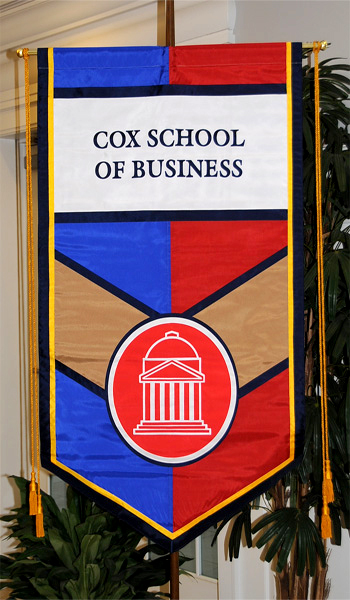
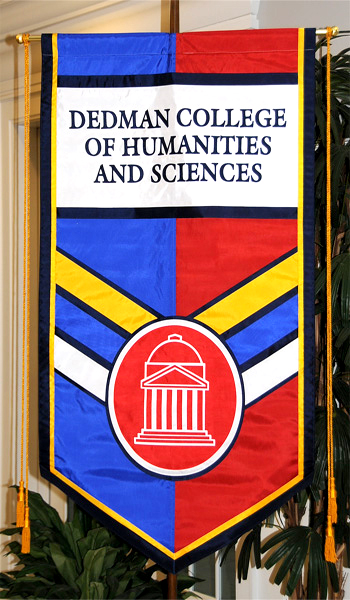
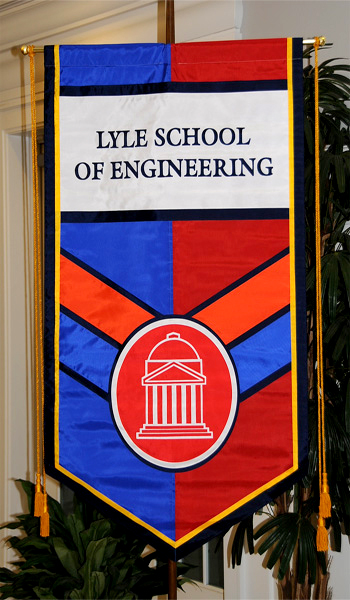
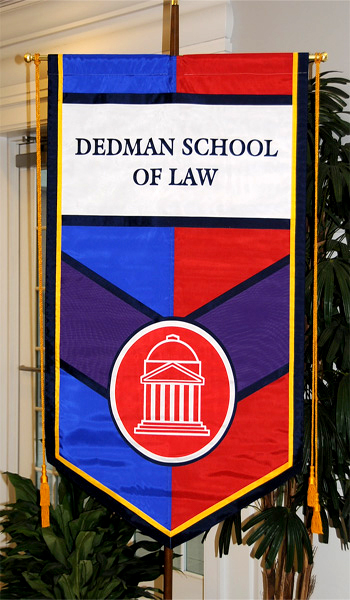
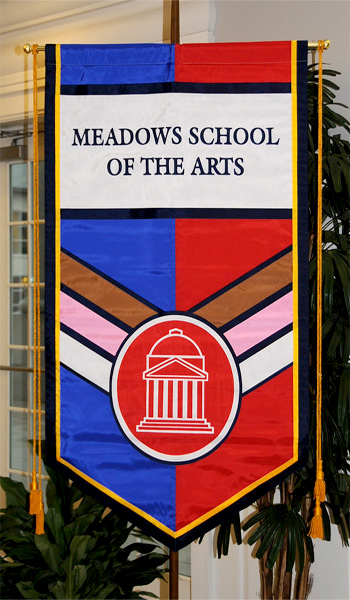
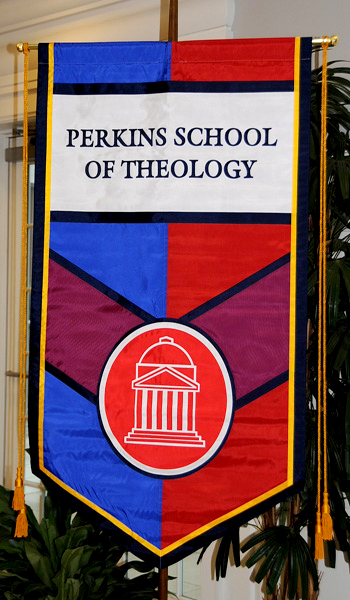
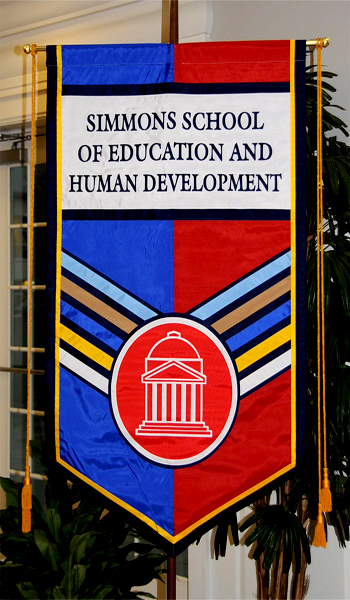
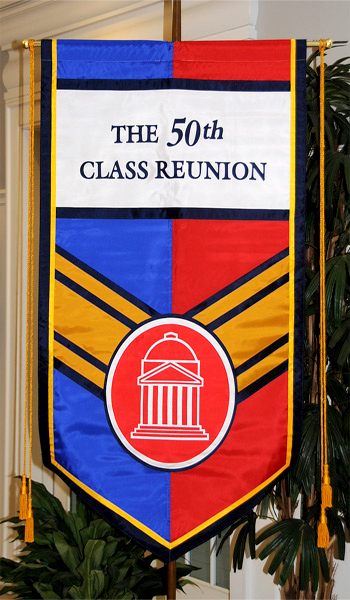
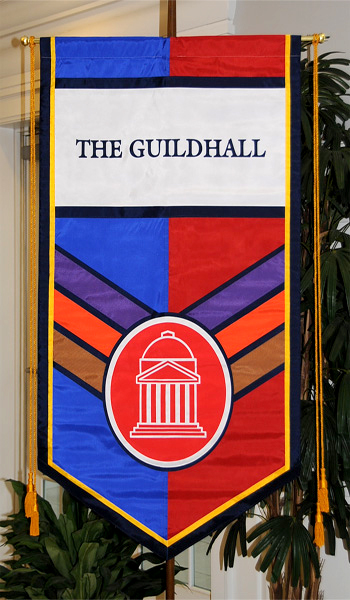
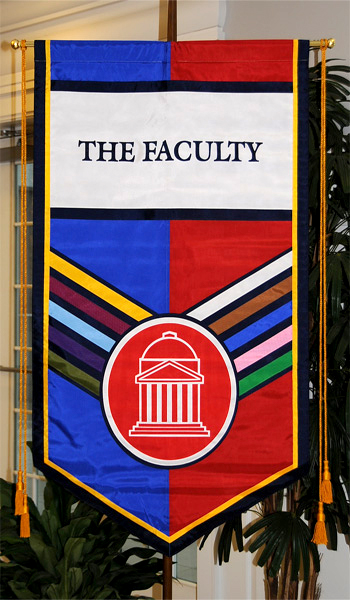
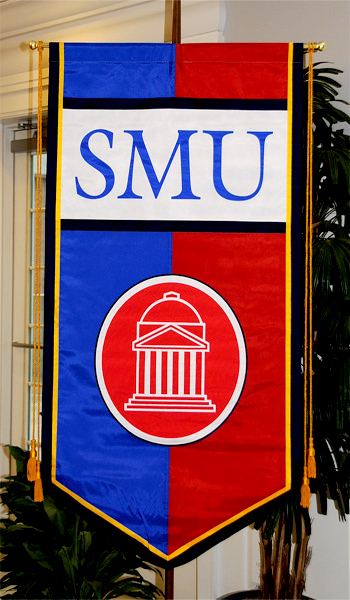
Guild of Marshals
SMU’s Guild of Marshals includes the chief marshal, platform and ceremony marshals, faculty marshals, procession marshals and school marshals. The chief marshal recruits members of the faculty to help organize and lead students, faculty, alumni and Platform Party members during each of our academic ceremonies. Many marshals graciously serve our students and our University at ceremonies year after year. SMU’s marshals are identified by their bright red gowns with black chevrons.
Howard Lantern
Each year during the May Baccalaureate Service this lantern is handed down by the senior class president to a representative of the junior class, a symbolic passing of the light that sustains our University. The Howard Lantern serves as a reminder of the light of learning and intellectual curiosity that shines within the students, faculty and staff here at SMU.
The Howard Lantern is dedicated to Professor Lorn Lambier Howard, chief marshal emeritus of SMU from 1978–1987, in honor of his role in shaping the traditions and protocol of SMU’s modern-day academic ceremonies.

McKenzie Bible
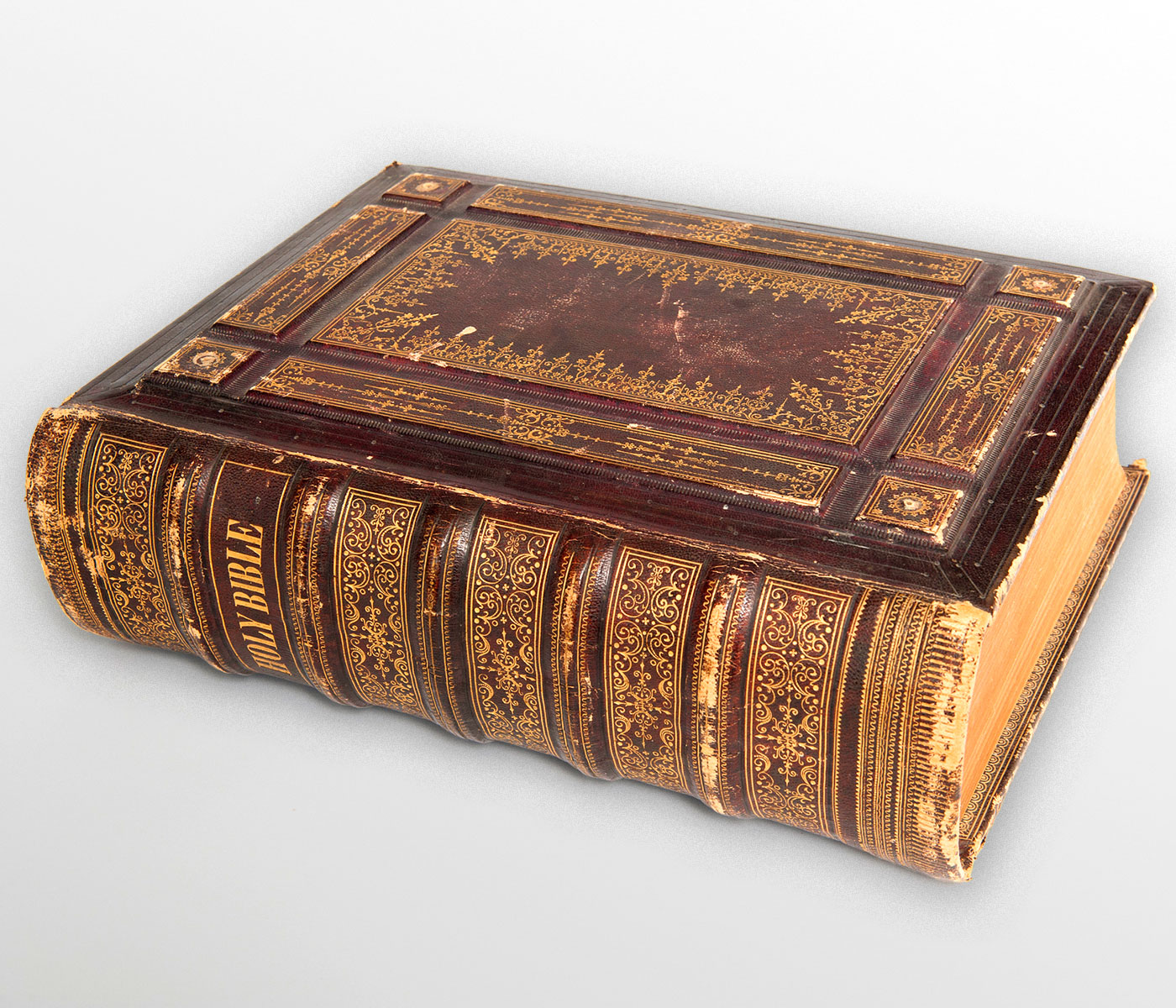
The McKenzie Bible was printed in 1856 and once was the property of J.W.P. McKenzie, a pioneer in Methodist education in Texas. It was used continually by McKenzie, who established McKenzie College at Clarksville – once the largest institution of higher learning in Texas. This historic Bible was presented to SMU in 1916 by Mrs. Milton Ragsdale of Dallas, Texas, a niece of McKenzie. The McKenzie Bible was first used at SMU’s 1916 Commencement Convocation, and the University is proud to use it at Baccalaureate Service.
Presidential collar and medallion
Chains of office, also known as collars, are custom designed bronze necklaces worn by the president during academic ceremonies as part of his or her regalia. The medallion of the necklace is dominated by the University seal, which represents the president’s responsibility to the sound education of every student at SMU. The bail, joining the medallion and the chain, represents the institution’s bond between the faculty and the student body. Equally, the 32-inch chain represents the joining of the desire to teach and the eagerness to learn demonstrated by SMU’s faculty and students.
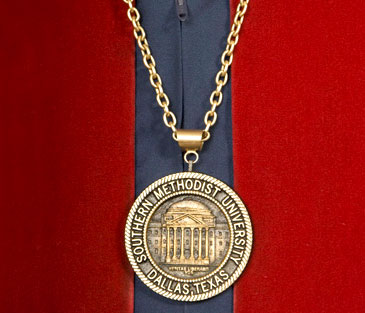
Rotunda Passage
One of the University’s most symbolic traditions is the Rotunda Passage, which includes both a processional and recessional. The passage recognizes the importance of Dallas Hall to SMU’s history as the oldest building on campus. Just as Dallas Hall is central to SMU, the Rotunda is at the very center of Dallas Hall.
Rotunda Processional
The Rotunda Processional, which takes place at the beginning of SMU’s Opening Convocation ceremony, marks the moment when entering first-year and transfer students become a part of the SMU community. During the processional, students march through the back of Dallas Hall and are guided to emerge from the front doors by alumni who are also parents of entering students. From the steps of Dallas Hall, students are led into McFarlin Auditorium by Peruna, a living symbol of the University. At the conclusion of Convocation, the historic Ovilla Curtain is lowered to signify the completion of their initiation.
Rotunda Recessional
During Rotunda Recessional, graduating students take their final walk on campus. The evening before May Commencement, candidates will leave McFarlin Auditorium in their academic regalia guided by alumni marshals. At the conclusion of the Baccalaureate Service, they will march up the stairs and through the front doors of Dallas Hall to symbolically complete their journey
SMU motto
Veritas liberabit vos
The SMU motto is veritas liberabit vos, translated from Latin as “the truth will make you free.” President Robert Stewart Hyer, SMU’s first president, selected the phrase, and it was approved by the Board on March 29, 1912. You will find the motto featured in several prominent locations on campus and incorporated into some the University’s symbols of tradition.
Regalia
Candidates for degrees at SMU are robed in custom regalia designed to incorporate SMU’s red and blue colors and symbols. SMU’s regalia reflects the University’s traditions and spirit. These unique gowns further enhance the great celebration of graduation and show our pride in our newest graduates.
The doctoral gown in admiral blue includes scarlet velvet chevrons and panels, gold embroidery and braids and the SMU seal. The candidates’ degree is represented in the color of the velvet trim on their hood. Replacing the traditional mortarboard, a crimson red velvet tam with a gold silk tassel completes the regalia.
The master’s gown, also in admiral blue, has a front yolk outlined in red braid with an embroidered SMU seal. The candidates’ degree is represented in the color of the tassel worn on the mortarboard and the color of the velvet trim on their hood.
The bachelor’s gown in admiral blue is worn with a tassel and mortarboard. A red silk stole embroidered in blue with the SMU seal is worn across the shoulders.

Doctoral gown

Master’s gown

Bachelor’s gown
SMU seal
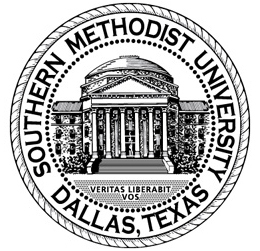
The official University seal, which features Dallas Hall, is a significant element in the University’s historic identity. Please refer to and follow the University seal brand guidelines.
Ovilla Curtain
The Ovilla Curtain is a historic fire curtain that is symbolically lowered at the end Opening Convocation, a ceremony in which new students are welcomed to the SMU community. After entering first-year and first-year transfer students have completed the Rotunda Passage and at the conclusion of their Opening Convocation ceremony, the historic Ovilla Curtain is lowered to signify the completion of their initiation.
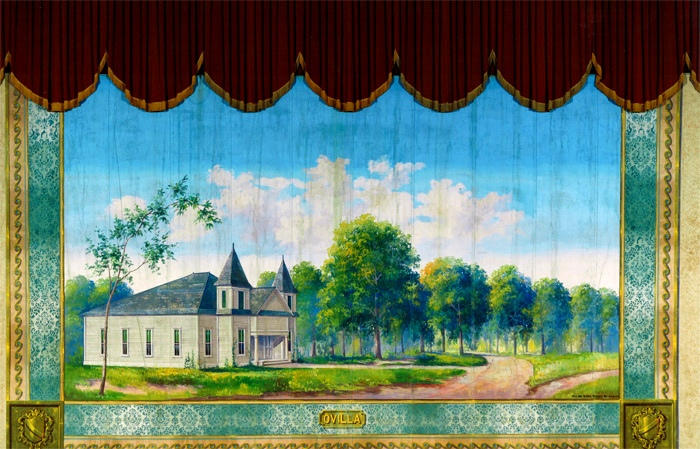
SMU songs
Varsity – official school song
In 1916 as SMU theology student Lewis N. Stuckey was driving to school one morning, he saw the University far in the distance and was inspired to write a song. In 1929, Varsity was adopted by SMU as its official school song.
A vocal precentor, traditionally a graduation candidate, leads the ceremony participants in Varsity at the conclusion of Opening Convocation, December Commencement and the Baccalaureate Service.
Unique to Commencement Convocation each May, the lights of Moody Coliseum are dimmed as Varsity is played by Imperial Brass. Graduation candidates are encouraged to bow their heads in silence, close their eyes and reflect on their time at SMU as the song is performed. This is the only time Varsity is presented in this format, and it is always a moving occasion.
Oh we see the Varsity,
Varsity, Varsity,
As she towers o’er the hill
Over there.
And our hearts are filled with joy,
SMU, SMU,
Alma Mater, we'll be true
Forever!
SMU Forever
While Jimmy Dunne, award-winning songwriter, composer and entrepreneur, was on campus with his daughter Kaitlyn – then a first-year student – he imagined how quickly time would fly before she graduated. As he watched her walking along the scenic, tree-lined Boulevard toward him, a melody and lyric came to him. By the time she reached him, he had written the verse and chorus to SMU Forever.
SMU
You will always be
In my heart forever
Who’s to say where my life may go
But deep inside I know
I will feel the trees
Blanket over me
Strolling back in time
Down the Boulevard
I will taste the spring
When the azaleas sing
How these memories bring
Joy inside my heart
University mace

The 22-pound mace is linked to the inauguration of President Willis Tate (1954–1972) and is now known as the Tate Mace. The 57-inch staff is topped by an orb that represents the University’s worldly authority. The orb is impressed with the seal of the University and encircled with SMU’s motto, veritas liberabit vos. Surmounting the orb is a cross vividly painted in SMU red, a reminder of SMU’s religious heritage.
The mace, carried at the front of formal processions, requires bystanders to note the authority and integrity of the event. The mace-bearer, the president of the Faculty Senate, leads formal ceremonies carrying this visible reminder of the University’s history and status.